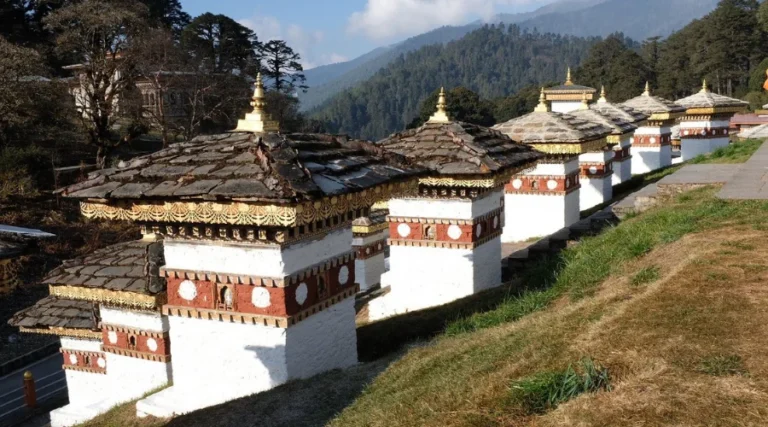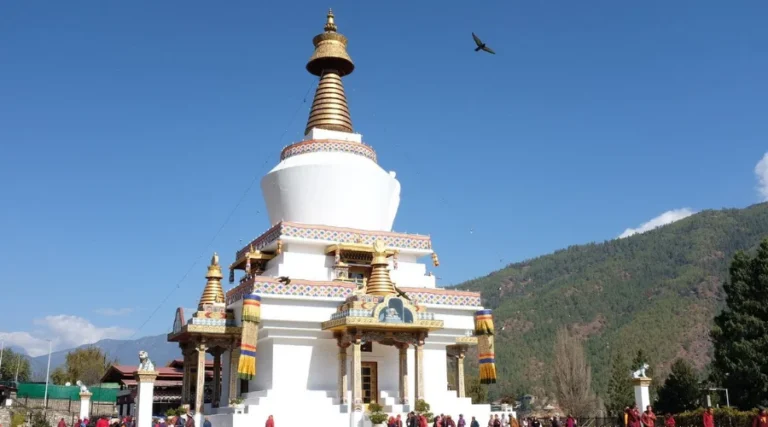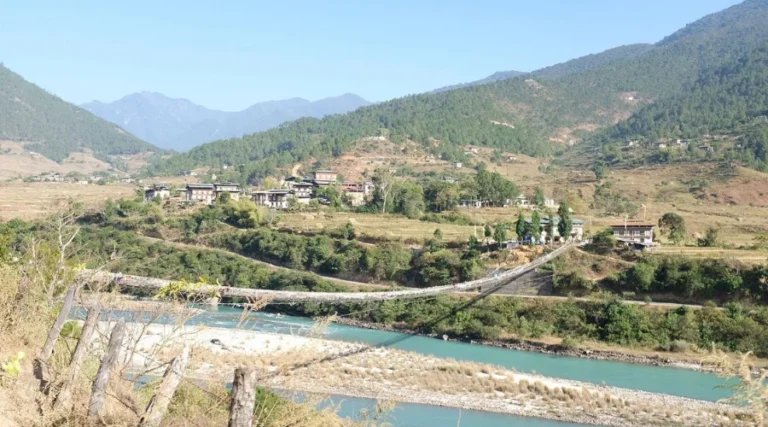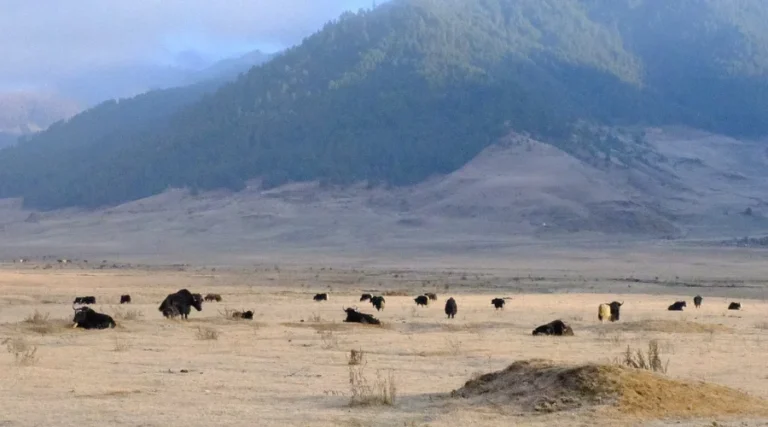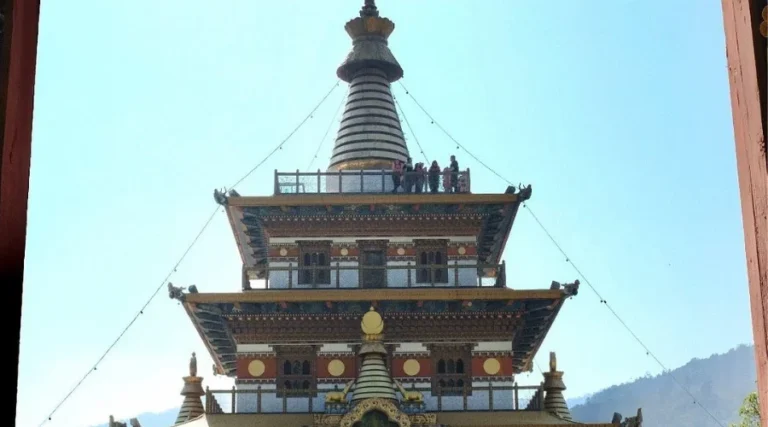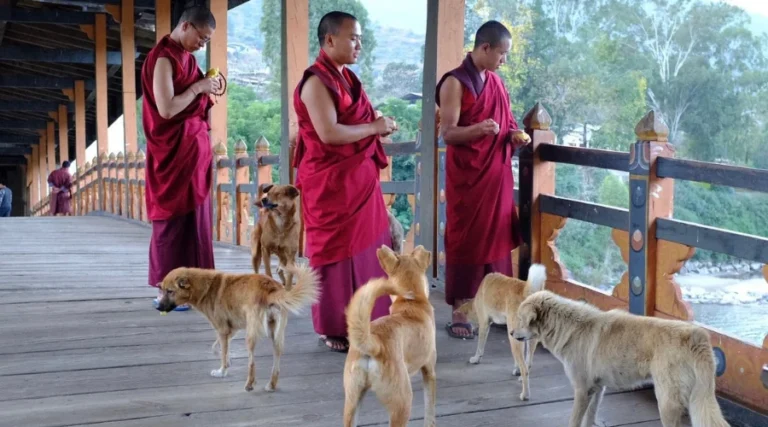China Tibet Nepal Bhutan Tour
-

Trip Duration 15 Days
-

Max, Altitude 5150 m / 16896 ft
-

Type Comfortable
-

Best Season Spring and Autumn
-

Meals Breakfast, Lunch and Dinner
-

Accommodation Hotel and Train
-

Activity Sightseeing Tour
-

Difficulty Easy
- Visit Chengdu Giant Panda Base to see adorable pandas in their natural habitat.
- The scenic Qinghai-Tibet train journey through breathtaking landscapes.
- Explore Lhasa’s iconic Potala Palace, Jokhang Temple, and Barkhor Street.
- Experience the unique monk debates at Sera Monastery and visit Drepung Monastery.
- Travel from Lhasa to Shigatse via Gyantse, stopping at the stunning Kumbum Stupa.
- Visit Everest Base Camp with spectacular views of Mount Everest.
- Drive through Tibetan and Nepali countryside from Gyirong Border to Kathmandu.
- Discover Kathmandu’s UNESCO sites: Durbar Square, Swayambhunath, and Patan.
- Scenic flight from Kathmandu to Paro, Bhutan, with stunning Himalayan views.
- Explore Thimphu and its famous Buddha Dordenma statue.
- Hike to the breathtaking Tiger’s Nest Monastery in Paro.
- Experience rich cultural heritage, peaceful monasteries, and traditional markets.
A China Tibet Nepal Bhutan Tour is a unique experience that takes you to breathtaking locations. Where the old, once charming essence of meeting the modern inspiring wonders of the 21st century. This article provides a complete guide to these tours.
In China, classic landmarks such as the Great Wall and Tibet can provide a type of different peace one needs for one’s mind.
Nepal has the great Himalayas and splendour, but Bhutan is instead a fine-looking place with an atmosphere of fairy tales and historical sites like the famous Tiger’s Nest Monastery.
This journey also has natural beauty, as seen in the images. This is the huge steppe of China, the towering plateaus of Tibet, the snowy peaks of Nepal, and the green-valley country of Bhutan.
The China, Tibet, Nepal, and Bhutan tour is handy and interesting. It shows in rich detail how these countries differ in scenery and culture.
Visa and Permits for China Tibet Nepal Bhutan Tour
Visas and permits are necessary for travel to China, Nepal, Bhutan, and Tibet. Depending on each location’s rules, preparing in advance is justified. For China, a tourist visa must be requested, which can be obtained from the Chinese embassy or consulate.
Nepal can also provide visa-on-arrival facilities to many border nationals so citizens can arrive without trouble when travelling. In Bhutan, all visitors are expected to book a tour with an authorized tour operator, and the tour operator must obtain a tourist visa.
Tibet Travel Permit shall be applied for at the same time as the Chinese visa. One may suspect that, depending on whether and how you will enter protected areas (e.g., Everest Base Camp), some additional permit will be needed (e.g., the Alien Travel Permit or Frontier Pass).
As the law may change, you should never assume that recent standards apply before travel. Requests for valid passports should be at least 6 months old, and photocopies of the authorization/permits and/or visas are required.
Popular Entry and Exit Points for China, Tibet, Nepal and Bhutan Tour
China:
Beijing and Chengdu are the major gateway cities for tourists in Tibet. Chengdu is attractive because it is on the Tibetan border and has extensive air and rail access to Lhasa.
Tibet:
Two ways to enter Tibet: fly to Lhasa or take the rail route. Gyirong Port is an in-and-out access point for Nepalese long-distance land travel.
Nepal:
Kathmandu is the doorpost for the traffic of the external community and the regional community of tourists. The Tribhuvan International Airport (TIA) in Kathmandu provides a route from Tibet and Bhutan to Nepal.
Bhutan:
The control of Paro is the main entrance to Bhutan. Individuals who go sightseeing and sightseeing by land in the direction of India generally do so by crossing at the Phuentsholing border point furthest from it.
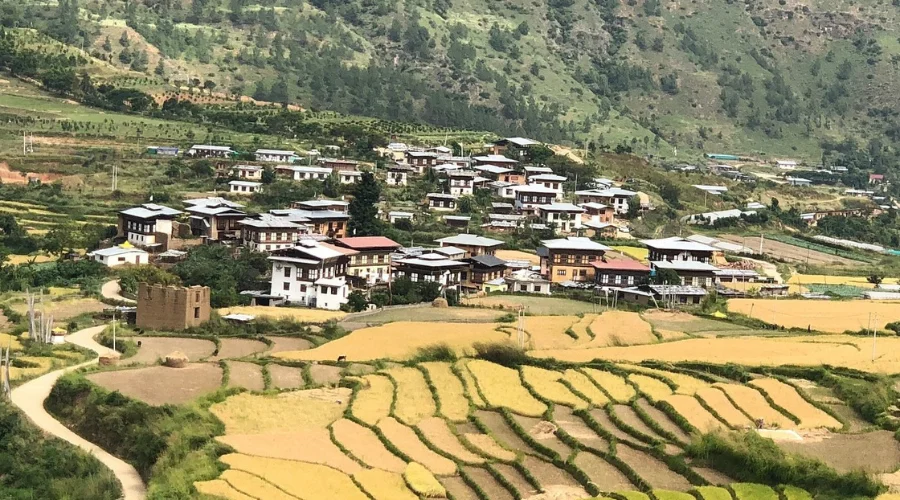
Short Itinerary
Itinerary of China Tibet Nepal Bhutan Tour
After you arrive at Chengdu airport, you will see a sign board and a car where your local representative will be waiting to help you with a transfer to the hotel.
Chengdu is one of the oldest cities in China and has a great history; the food there is strong flavoured and spicy-sour, and people there do not hurry. At once, check in at the hotel and then relax and feel glad you are on holiday.
Walk about the neighbourhood streets and enjoy some fun Sichuan food (hotpot or map tofu) in restaurants.
Otherwise, you may go to Jinli Ancient Street, which is listed as a characteristic and lively place where historical and cultural stories of Chengdu city are displayed in contemporary society.
- Hotel in Chengdu
- Dinner Included
Every day should begin with a trip to the Chengdu Research Base of Giant Panda Breeding, looking at the cute giant pandas standing before you. Here, you’ll see pandas in their natural habitats, playing, eating bamboo, and even tiny cubs in the nursery (if you’re lucky! ).
Understand conservation practice and the facility’s contribution to endangered species conservation. Every day, one must stand at the railway station and board the legendary Qinghai-Tibet railway.
Travel by train is the beginning of a fantastic “world” with its unexpected turns and the advent of the future while travelling to Tibet. Have a comfy bunk, and get comfortable because a great trip is in store for you.
- Overnight in Train
- Breakfast, Lunch and Dinner
Ride on the train sightseeing on the Qinghai-Tibet Plateau in one day. It is the highest railway line in the world, with incredible views outside your window.
However, progressively, from the expansive plains and shimmering rivers to the stark peaks and imposingly beautiful monasteries, the vista is never static. At the train station, an oxygen supply apparatus is available for acclimatization to hypoxia, i.e.
Relax, slow down, and let the day pass. Eat on the plane and plan to return to Lhasa the next day.
- Overnight in Train
- Breakfast, Lunch and Dinner
You’ll arrive in Lhasa, Tibet’s spiritual and cultural heart, in the afternoon. Lhasa, 3650 m, at the utmost scenic beauty, is an architectural religious capital. At the airport, your gatekeeper will take you to the hotel.
Acclimatization to high altitude should be quietly passed today. Drink fluids, eat as little as possible and do not engage in any active movement. If you wish, take a short trip on foot down the street outside the hotel and get a feel of the amazing spirit of this old district.
- Hotel in Lhasa
- Breakfast, Lunch and Dinner
Your stay in Lhasa starts with a visit to the Drepung Monastery, the biggest monastery in the world and a centre for great Tibetan Buddhist architecture.
It is worth touring the stunning rooms, admiring the pretty walls, and learning about the museum’s history.
After lunch, go to Sera Monastery, known for its monk debates in the courtyard.
- Hotel in Lhasa
- Breakfast, Lunch and Dinner
Upon arrival, escort the visitor to the world heritage site, the former residence of the Dalai Lama, Potala Palace. That massive red and white building is the image of Tibetan Buddhism, and it looks down upon a panoramic view of the city.
Over there, look closely at its temples, stupas, and riches and conclude its history into how Tibet lives today. Right, then head for Jokhang Temple, the centre of Tibetan Buddhism. Tibetan yogis lie flat on the ground and circle the temple.
End the day by walking down Barkhor Street, a bustling street where tourists can find tourist trinkets, prayer flags, and information about this culture.
- Hotel in Lhasa
- Breakfast, Lunch and Dinner
Take the scenic road from Gyantse to Shigatse and get off here. If travelling, deviate slightly with directions to Yamdrok Lake, a holy and scenic lake in Tibet.
With turquoise waters in the background, the white (powder) snow mountains are a stunning scene. Take a short drive to the beautiful Karola Glacier and then Gyantse.
Visit the Kumbum Stupa and Pelkor Monastery, of which the former is historic and is noted for its unique architecture. Last, you will stay here in Shigatse (the second city in Tibet).
- Hotel in Shigaste
- Breakfast, Lunch and Dinner
Today is one of the most thrilling days of your journey. Travel through rugged mountain roads toward Everest Base Camp.
On the tour, take a side trip to Gawu La Pass and visitors can take in breathtaking scenery of the highest summits in the world, including Mount Everest.
Entering base camp, one is struck by the sheerly magnificent grandeur of Mount Everest in scale and might even convert everyone on the expedition to be in awe.
Spend a night enjoying the tranquillity of the Himalayas and having a night stay at the base camp’s foot.
- Stay in Everest Base Camp
- Breakfast, Lunch and Dinner
After an unforgettable day at Everest Base Camp, you’ll begin your journey to the Gyirong Border. The drive gives more stunning views as you pass through Tibetan villages and rugged landscapes.
Once you reach Gyirong, you’ll cross into Nepal and stay in a nearby town. You’ll have time to relax and prepare for the next part of your journey.
- Hotel in Gyirong
- Breakfast, Lunch and Dinner
Today, you’ll travel from the Gyirong Border to Kathmandu, Nepal’s vibrant capital. The drive takes you through beautiful valleys and small villages.
As you approach Kathmandu, you’ll see the green hills and terraced fields that make Nepal so picturesque. Once in Kathmandu, you’ll check into your hotel.
The rest of the day is free to explore the city, relax, or visit local shops.
- Hotel in Kathmandu
- Breakfast, Lunch and Dinner
Explore the historical and fascinating city of Kathmandu today. Durbar Square is a cultural complex of temples, palaces, and courtyards that is a world heritage site.
Next, they must visit Swayambhunath, also known as the Monkey Temple. It is situated on top of a hill with sweeping views of the city.
Lastly, visit Patan, which is famous for its craftsmanship and the places where it originated. Each site offers a different perspective on Nepal’s history and culture.
- Hotel in Kathmandu
- Breakfast, Lunch and Dinner
You will feel quite adventurous on a commercial flight to Paro, Bhutan, one of the most interesting flights over the Himalayas. Once the flight arrives, a guide will meet you and take you to the capital of Bhutan, Thimphu.
The trail is an occasionally interrupted view of beautiful scenery and flashes exquisite samples of Bhutanese architecture.
Spend the night walking purposelessly around the calm Thimphu streets or have a good rest at the hotel.
- Hotel in Thimpu
- Breakfast, Lunch and Dinner
Take a morning tour of the major attractions. The Memorial Chorten site celebrates the life of Bhutan’s third king and houses the largest Buddha Dordenma statue.
After lunch, proceed to Paro, which has a scenic view of Bhutan.
- Hotel in Paro
- Breakfast, Lunch and Dinner
You will hike to the famous Tiger’s Nest Monastery, high on a cliff-top. The climb is hard but amazing, with stunning views of the Paro Valley.
Explore the monastery and learn about its past and its function as a centre of religious interest. Having descended, return to Paro and relax.
- Hotel in Paro
- Breakfast, Lunch and Dinner
This incredible trip across China, Tibet, Nepal, and Bhutan has now finished—Paro, with its spectacular views, colourful cultural traditions, and forever-lasting memories. Safe travels!
Have any Questions? Check out FAQ'S
Trip Essential Information
Best Time to Visit for China, Tibet, Nepal, and Bhutan Tour
Travelling time in the China-Tibet-Nepal-Bhutan region also indicates a high-quality travelling experience. Weather can vary depending on the location, so planning your trip according to the season is a valid strategy to enjoy the trip in full dose.
The favourable climate of the area is usually associated with spring (March to May) and autumn (September to November) weather, sunshine, heat and transparency.
It is most practical to visit Tibet during the following periods: Summer is a convenient season to travel to Tibet, and the weather in the Tibetan plateau is favourable, allowing visitors to enjoy the pristine Himalayan scenery unobstructed.
Trekking and sightseeing in Nepal are preferred during spring and autumn when milder and drier weather is available. Bhutan is equally beautiful during these months when early spring flowers emerge, and autumn is so clear that it resembles a glass waterfall.
Do not travel during the monsoon season (June to August), as severe rainfall in Nepal and Bhutan could cause travel disruption.
How to Travel Between the Countries
Travel to and from China, Tibet, Nepal, and Bhutan involves careful route planning that necessitates combining air, ground, and border crossings. Each type of movement is a single experience, like air travel and the stunning natural driving scenery.
Flights Between Countries in China, Tibet, Nepal and Bhutan Tour
China to Tibet:
Air travel is the most convenient mode of transportation from China to Tibet. Among the major metropolises (e.g., Beijing, Shanghai, and Chengdu) are day trips to the capital, Tibet, and Lhasa. Air travel is a modern mode of transport, but there is no joy in travelling.
Tibet to Nepal:
Flights from Lhasa to Kathmandu are common (1.5 h). This itinerary provides stunning views of the Himalayas, where Everest is located, and is generally regarded as one of the most scenic flights in the world.
Nepal to Bhutan:
Flights to Paro (Bhutan) can be flown above by Druk Air and Bhutan Airlines from Kathmandu. The route is not so long (1 hour), but on the other side, the view of the Himalayas beneath is truly magnificent.
Overland Routes
China to Tibet:
Travelling by the Qinghai-Tibet line from Xining to Lhasa is obligatory. The station is the largest railway station in the world, with a stunning view of snowy mountains and steppes. Overland transport from Chengdu or Kathmandu to Lhasa is also feasible, but it will likely require permission and an organized trip.
Tibet to Nepal:
The Overland route via Gyirong Port is a common option. The trail presents extreme views, from the highest alpine passes to alpine lakes, the Tibetan plateau, and down toward Nepal.
Nepal to Bhutan:
Vehicle travel between Nepal and Bhutan is less frequent due to the lack of an uninterrupted road connection. The quickest way is by flight to Paro. But if you want to see India on the road, you can enter India overland and cross into Bhutan via the Phuentsholing border.
Tips for Seamless Travel
- Check all countries’ visas and ensure all required documents are properly prepared.
- By route and weather, air and ground routes are planned.
- Travel to Tibet and Bhutan must be done through a licensed travel agent. Independent travel is not permissible in either country.
- Delayed flights, especially on flights, possibly cause increased travel time.
Top Attractions in China
China’s travel combines centuries-old historical and cultural sites with modern marvels; various tourism experiences meet the traveller’s needs. No matter what ancient buildings or bustling streets, there is something to see for everyone.
Beijing: The Great Wall and Forbidden City
As the capital of China, Beijing has a concentration of landmark sites. The Great Wall of China is one of the most significant UNESCO World Heritage sites, and it has been running for tens of thousands of kilometres.
Shoppers can see the magic of the Great Wall and be impressed by its visual charm while strolling along the tourist line of the historical sites in the Mutianyu or Badaling section. Following the unit test, the Forbidden City, an old residence of 24 Ming and Qing emperors, is the subsequent sightseeing place.
Xi’an: Terracotta Warriors
As a historical city that gave rise to the Silk Road, Xi’an is famous for terracotta warriors (Cavillieri et al., 2018). The story waiting to be revealed in 1974, where a group of life-size, tens of thousands of warriors, buried to enshrine China’s first emperor (Qin Shi Huang) in the next life, was an accident finding.
An excursion to the Terracotta Army Museum is a trip back in time, a visit to the most ancient empire in Chinese history.
Shanghai: Modern Architecture and Culture
Shanghai (China, a modern mega city) is where one might pause and never stop being (modernity and antiquity in their elemental structure). Now, the Pudong district skyline, with the foreground of the No.1 Pearl Tower and the background of the Shanghai Tower, is a feast for the eyes.
Do not miss the renowned Yu Garden, which is tranquil and has oriental buildings. Across the street, you can experience the city’s vigour.
Exploring the Mystical Tibet
Tibet is internationally famous for its magical abilities, immense tableland landscapes, culture, and mystical way of life. They are also one of Tibet’s most striking features of its artistic appeal and cultural richness.
Lhasa: Potala Palace and Jokhang Temple
Concerning religion, the city (Lhasa) is in two of the region’s most sacred and important locations. The Potala Palace is a Tibetan Buddhist landmark and the winter home of the Dalai Lama.
The Jokhang Temple, located in the urban area of Lhasa, is also worth visiting. It is the holiest site in Tibet, and people from all over the world visit it.
Everest Base Camp from the Tibetan Side
Among those who prefer travelling in unknown terrains, the tour to EBC, situated in Tibet, China, is an amazing journey that can be met once in a lifetime.
Facility to approach on the Tibetan side of Everest. It has fewer visitors and provides an excellent view of the tallest mountain on the earth’s surface.
Travelling from Lhasa to the EBC places visitors at the briny of the splendid Tibetan high-altitude lakes, desert and mountain snow. Although the greatness of the mountain’s size is always there as something to admire, there is something rather humble about lounging right at the foot of Mount Everest.
Tibetan Culture And Customs
Tibetan men and women perform joyous, colourful religious festivals during major religious events. For example, Losar, the Tibetan New Year, Saga Dawa, and others include folk dance and humanitarian activities, such as giving food and other necessities to needy people.
Thangka painting and mandalas (synonym forms with Buddhist arts (Buddhist motifs, and/or symbolic manifestations of Buddhist principles (Shingon Buddhism / Vajrayana Buddhism).
Nepal: The region of Mountains and Culture
Nepal has been popularised mainly for its mountainous terrain, diverse culture, and religious importance. For those with restless vacations, the country is now in the sunshine.
Kathmandu Valley and its World Heritage Sites
Kathmandu Valley is a cultural region of Nepal. It has seven historically significant World Heritage sites. Visitors can visit Swayambhunath, Bouddha, or Pashupatinath.
On the same line, Boudhanath Stupa, also an important Buddhist shrine in Nepal, is perhaps one of the most important Buddhist pilgrimages.
For example, several buildings in the Kathmandu Durbar Square area contain hints about the history of the Nepalese monarchy – palaces, temples, sculptures.
Pokhara: Adventure and Scenic Beauty
The lakeside village, with magnificent views of the Annapurna range behind, is known for its serenity. Lying on a Phewa lake tour is possible, or a Sarangkot viewpoint climb is scenic with the sun up on the snow-capped white summit.
Pokhara is also an entry point to many trekking routes, such as the famous Annapurna Circuit or the Annapurna Base Camp trek.
For those who want to have a fun time tobogganing, glider, zip wire fast descent, raft ride and many other activities, all in one place.
Mount Everest and Trekking Options
It is impossible to visit Nepal without seeing the wonderful Mount Everest, in some way, on whatever trip one undertakes. Nepal is the point of entry for many itineraries to the base of the highest mountain on Earth.
The Everest Base Camp Trek is one of the safest and most rewarding treks. It provides a breathtaking view of the Everest region, a historical experience of interacting with Sherpa villages, and a glimpse of Tibetan Buddhist culture.
There are several other trekking areas in Nepal, Annapurna, Langtang, and Manaslu, and visitors can get lost in the beauty of nature and the culture of the local people, aside from Everest.
Discovering the Kingdom of Bhutan
Bhutan, the “Land of the Thunder Dragon,” is a small country with a spiritual, evocative, profound culture, stunning landscapes, and artful mystical rituals.
Thimphu: Cultural Landmarks
The capital of the country, Thimphu, Bhutan, is ideal as a base from which to experience the country’s beauty. The unique combined fortress-monastery Tashichho Dzong is not only the centre of work for the administration.
It is also feasible to walk into the palaces to observe Buddha Dordenma, a giant statue set up on top of the valley, and control the view from the valley with a commanding effect.
Thimphu is equally famous for the colourful local markets where the craft and handcrafts of the Bhutanese people, i.e., textiles, thangkas (scroll paintings) and woodcraft, are exhibited.
Paro: Tiger’s Nest Monastery
Paro is the site of one of Bhutan’s iconic architectural features, the Taktsang (the “conductress of the gods.” monastery. Sunbathing on the edge of a cliff, this (sacred) “monastery is believed to have been the meditation place of Guru Rinpoche in the 8th century.
Hiking up to the Mata temple is a special route that offers gorgeous views of the temple facade, mountains, and forest. Paro also has the Paro Dzong, a historic fortress that is a “point of reference” for matters religious and administrative in the valley.
Cultural Highlights of the Four Destinations
Family, food, and show themes are associated with Chinese lunisolar festivals (e.g., Chinese New Year and Mid-Autumn Festival).
Tibetan festivals such as Losar (Tibetan New Year’s Day and the Start of the new year) with rituals and festivals are also being followed and celebrated.
In the form of Dashain and Tihar, Hindu festivals in Nepal reflect the (changing) seasons and the worship of the gods.
In Bhutan, a Buddhist country, the locals practice the ritual of Tshechu, which involves watching mask dances accompanied by prayer.
Although China, Tibet, Nepal, Bhutan, and other countries claim to have independent cultures, they all share the same natural and religious attitudes toward nature.
Food and Cuisine to Try During the China, Nepal, and Bhutan Tour
While travelling through China, Tibet, Nepal, and Bhutan, you can sample food and drink from various sources. You can enjoy Peking Duck, dumplings, and flavorful hotpots in China.
Tibetan food, including momos (dumplings), thukpa, and tsampa (roasted barley flour), is satisfying. Nepali cuisine is based on staple foods such as dal bhat (entice stew and rice) and momo (wrappers), which are liked for their cosy flavour profiles.
Don’t miss Ema Datshi, the national dish of Bhutan, which is made with hot cheese and chillies.
Packing Tips for a Multi-Destination Tour
Packing for a multi-country trip demands preparation for various climate conditions. Carry different clothing layers to adapt to climatic variations, such as being hot in the lowlands and cold in the high mountains.
Nepal and Tibet are regions where comfortable walking is feasible. Also, remember to wear cultural costumes or conservative religious dress to religious places or festivals in Bhutan.
Sunscreen, a hat, and a portable water bottle are also essentials regardless of the destination.
Budgeting and Costs for the Tour
Travelling costs from several Asian countries, such as China, Tibet, Nepal, and Bhutan, can be customized to your requirements.
Accommodation varies from the cheapest hostels to the most luxurious hotels. It is more expensive in Tibet and Bhutan due to the need for a permit. Restaurant food is a relative bargain, but one gets vastly overcharged if one lives in a metropolis like Beijing or Kathmandu.
Travel costs are high, and air travel is the most expensive. As a saving measure, please book your accommodation in advance, travel by public transport, and look for group tours with discounted rates.
Challenges and Tips for First-Time Travelers
First-time travellers may face some challenges during their journey. Altitude sickness is something to be careful of, especially in Tibet and Nepal— so don’t rush and hydrate.
Modest dress, behaviour, and Buddhism) are integral to Bhutan, where it is a fundamental society. For example, in this case, language and communication difficulties will also be present, i.e.
This can be overcome in China by learning a couple of simple sentences or using a translation device. Preparing will help make the journey more pleasant.
Why Choose a Guided Tour?
A guided tour will enhance and enrich your experience by providing information on the history and culture of the local area.
The feature of group tours, common experience tours, provision of one of the advantages of group tours, and a local one can overcome language difficulties and difficulties of logistics.
Many reputable tour operators, like Himalayan Trekking and Tours, offer full packages that include transport, lodging, permit fees, and activities. Thus, you can relax and travel.
Frequently Asked Questions (FAQ)
The total duration of China Tibet Nepal and Bhutan tour is 15 days including the arrival and departure.
- Instant Confirmation
- Free to customize
- Support anytime
© 2025 - Himalayan Trekking and Tours (P) Ltd. All Rights Reserved.











